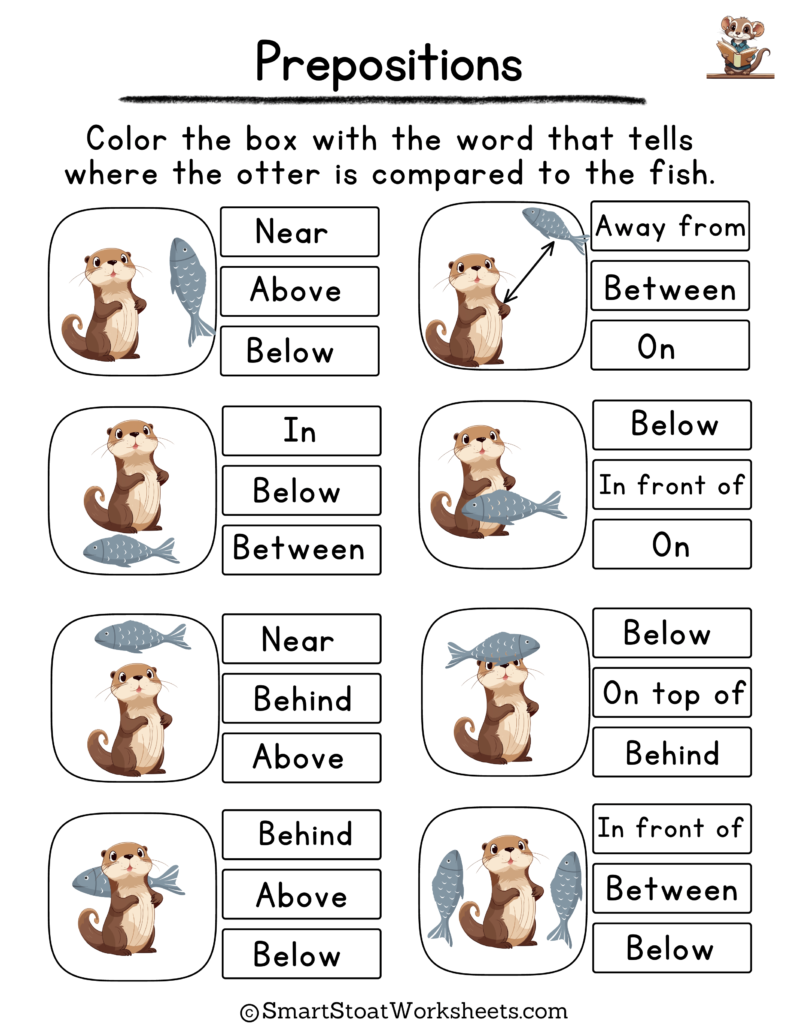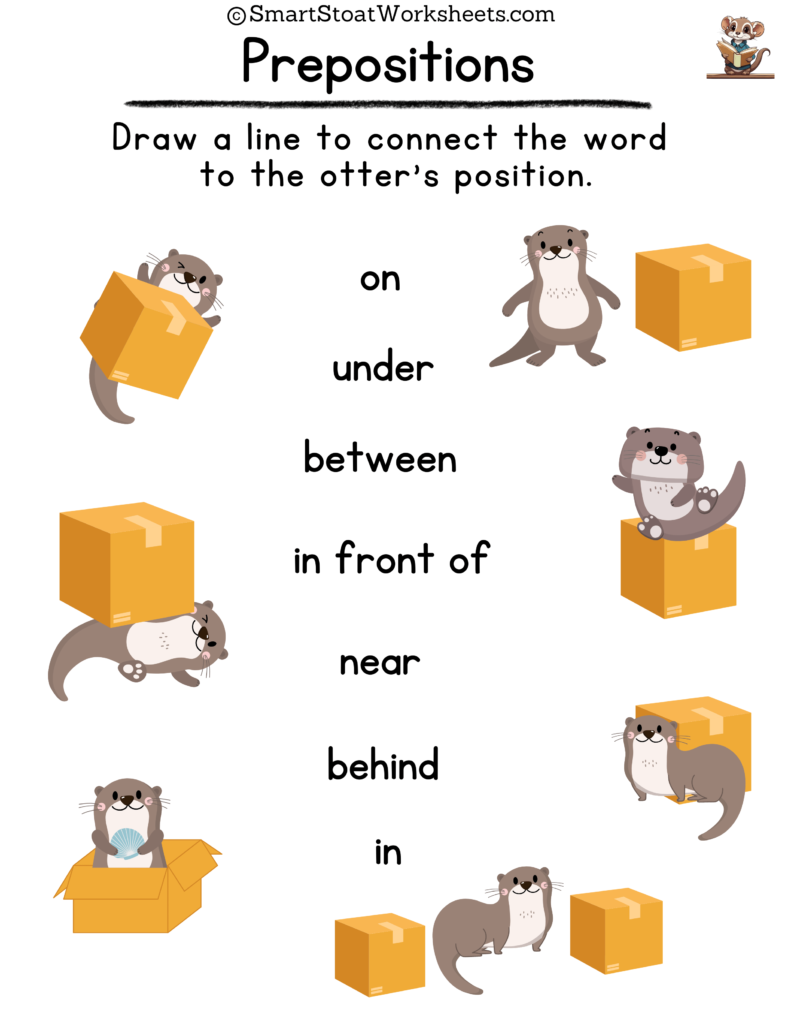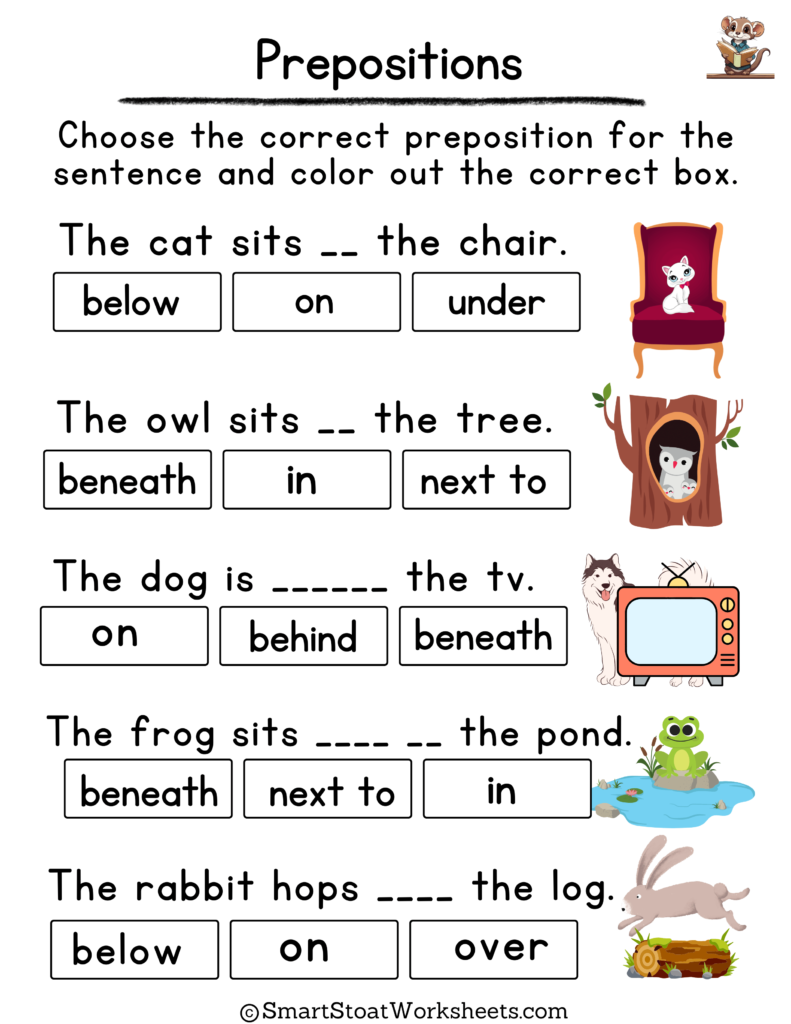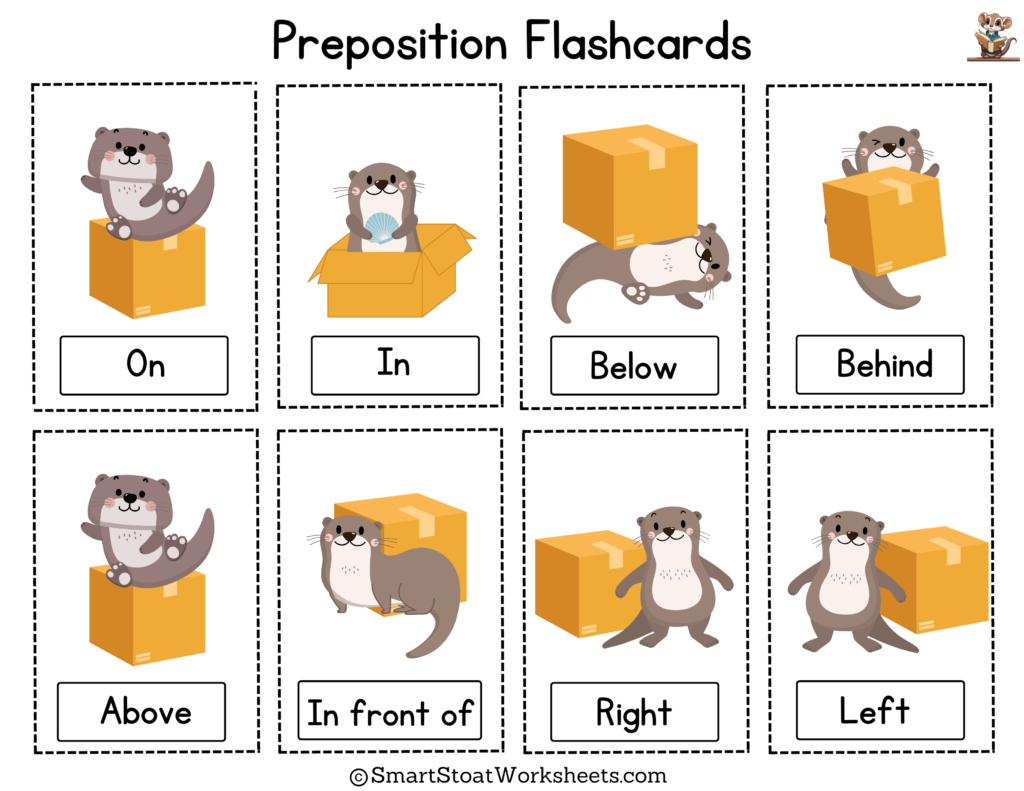Prepositions are the little words that pack a big punch in sentences! They tell us where or when something happens, like “under,” “beside,” or “before.” Mastering prepositions early on helps young learners develop their understanding of sentence structure, spatial awareness, and logical thinking. That’s why our Prepositions Worksheets for Kindergarten are here to make learning fun, engaging, and super effective!
To start your download, simply click the worksheet(s) you want, then download and print the PDF—no sign-up required!
Designed with the littlest learners in mind, these worksheets are perfect for preschool and kindergarten kids who are just starting to explore the world of writing. Packed with vibrant visuals, fun activities, and interactive tasks, each worksheet helps your child grasp the concept of prepositions while improving their fine motor skills and sentence-building abilities. Whether your young learner is identifying where the cat is sitting or where the ball is rolling, they’ll get a head start on language skills while having a blast!
And the best part? These worksheets are FREE! You can easily download them in PDF format, making them ideal for both teachers and parents. No fuss, no cost—just instant access to valuable learning resources right at your fingertips. They’re perfect for classroom lessons, homeschooling, or even a quiet activity at home on a rainy day.
So why wait? With our prepositions worksheets, you’ll turn “on,” “in,” and “under” into words your child will confidently use in their writing. They’re not just educational—they’re a stepping stone toward better communication and cognitive skills! Get started now and watch your little ones become preposition pros!
Let’s face it—learning prepositions can be tricky for kids, but we’ve made it easy and exciting. Whether you’re a teacher crafting the perfect lesson plan or a parent looking for educational activities that don’t require hours of prep, these downloadable PDFs are the ideal resource. Grab them today, and set your child on the path to becoming a word wizard!
A Fun and Easy Guide to Teaching Prepositions to Your Preschool or Kindergarten Kid Using Smart Stoats Worksheets
Teaching prepositions to your little one can be a delightful experience, especially when using engaging resources like our Prepositions Worksheets for Kindergarten and Preschool Kids. With the right approach, you can turn learning prepositions into an exciting journey filled with creativity and exploration. Here’s a step-by-step guide to help you teach prepositions using our worksheets, and make it a fun experience for both you and your child!
1. Start with Simple, Everyday Examples
Before diving into the worksheets, introduce your child to prepositions through real-life examples. You use prepositions all the time without realizing it, like when you say, “Put your toy on the table” or “Stand beside me.” Point these words out during daily activities:
- “The cup is on the counter.”
- “Let’s put your shoes under the bed.”
- “The ball is behind the chair.”
This creates a foundation that your child can relate to when they start working on the worksheets.
2. Pick the Right Worksheet
We’ve designed our worksheets to cover a range of prepositions in simple, easy-to-understand activities. Select a worksheet that matches your child’s current understanding or introduces one or two new prepositions. Our worksheets come in PDF format, so you can print them and start using them right away!
Here’s how you can choose:
- For beginners: Start with prepositions like “in,” “on,” and “under,” which are more concrete and easy to visualize.
- For advanced learners: Once they’ve mastered the basics, move on to trickier prepositions like “behind,” “beside,” and “between.”
3. Make It Interactive
Children learn best when they’re actively involved, so don’t just hand them the worksheet—turn it into a game! Use objects around the house to act out the prepositions in the worksheet.
For example:
- If the worksheet asks your child to circle the picture of the cat on the chair, you can place a toy cat on a chair in your home. Then, ask your child to point and say, “The cat is on the chair.”
- Bring in their favorite toys, like placing a teddy bear under a table or next to a book, to create real-life connections with the worksheet activities.
This playful approach reinforces the prepositions they’re learning and makes it feel more like play than work!
4. Talk It Out
While your child works through the worksheets, talk through each preposition with them. Ask open-ended questions to help them think critically:
- “Where is the ball? Is it under the table or on the table?”
- “What happens when we move the car behind the tree?”
Encouraging them to explain their thinking helps develop their language and reasoning skills. It’s also a great way to engage with them during the learning process.
5. Use Positive Reinforcement
Learning something new can be challenging for young kids, so celebrate their successes! If they correctly identify a preposition or complete a worksheet, give them praise like, “Great job! You knew the bunny was under the chair!” You can also use stickers or other small rewards to keep them motivated.
Positive reinforcement helps build their confidence and encourages them to keep learning.
6. Practice Daily
The key to mastering prepositions is regular practice. Integrate prepositions into your daily routine by continuing to point them out in everyday life:
- “We’re putting the crayons in the box.”
- “Your shoes are next to the door.”
Additionally, revisit the worksheets a few times a week to reinforce what they’ve learned. Since the worksheets are downloadable and free, you can print as many copies as you need for repeated practice without worrying about running out of materials!
7. Incorporate Fun Activities
Add extra flair to learning by incorporating hands-on activities. Here are some ideas:
- Treasure Hunt: Hide small objects around the house and give your child clues using prepositions, like “The toy is behind the couch” or “Look under the bed!”
- Preposition Bingo: Create a bingo card with prepositions and have your child place markers on the correct preposition based on sentences you read aloud.
- Art Project: Ask your child to draw a picture and describe it using prepositions—”The sun is above the house” or “The dog is beside the tree.”
These activities help solidify the concepts they’ve learned from the worksheets in a fun, memorable way.
8. Review and Reflect
After your child finishes a worksheet or completes a few lessons, take some time to review. Ask them to describe what they learned and test their understanding:
- “Can you tell me where the dog is in this picture?”
- “What does ‘under’ mean?”
Reviewing helps you assess what they’ve absorbed and what areas might need more attention. If they’re struggling with certain prepositions, revisit those worksheets and activities until they feel more comfortable.
Why Use Our Prepositions Worksheets?
Our prepositions worksheets are tailored for young learners, combining education with engaging visuals and easy-to-follow tasks. They’re designed to enhance your child’s writing skills while building their understanding of prepositions in an enjoyable way. And, since they’re free, downloadable PDFs, they’re convenient for both parents and teachers, making them perfect for any learning environment!
Ready to Get Started?
Download our free Prepositions Worksheets now and jumpstart your child’s learning journey. With these fun, interactive activities, your little one will become a preposition pro in no time! Whether you’re at home or in the classroom, these worksheets are your go-to resource for building strong writing and language skills while keeping your child entertained.
Happy learning!



